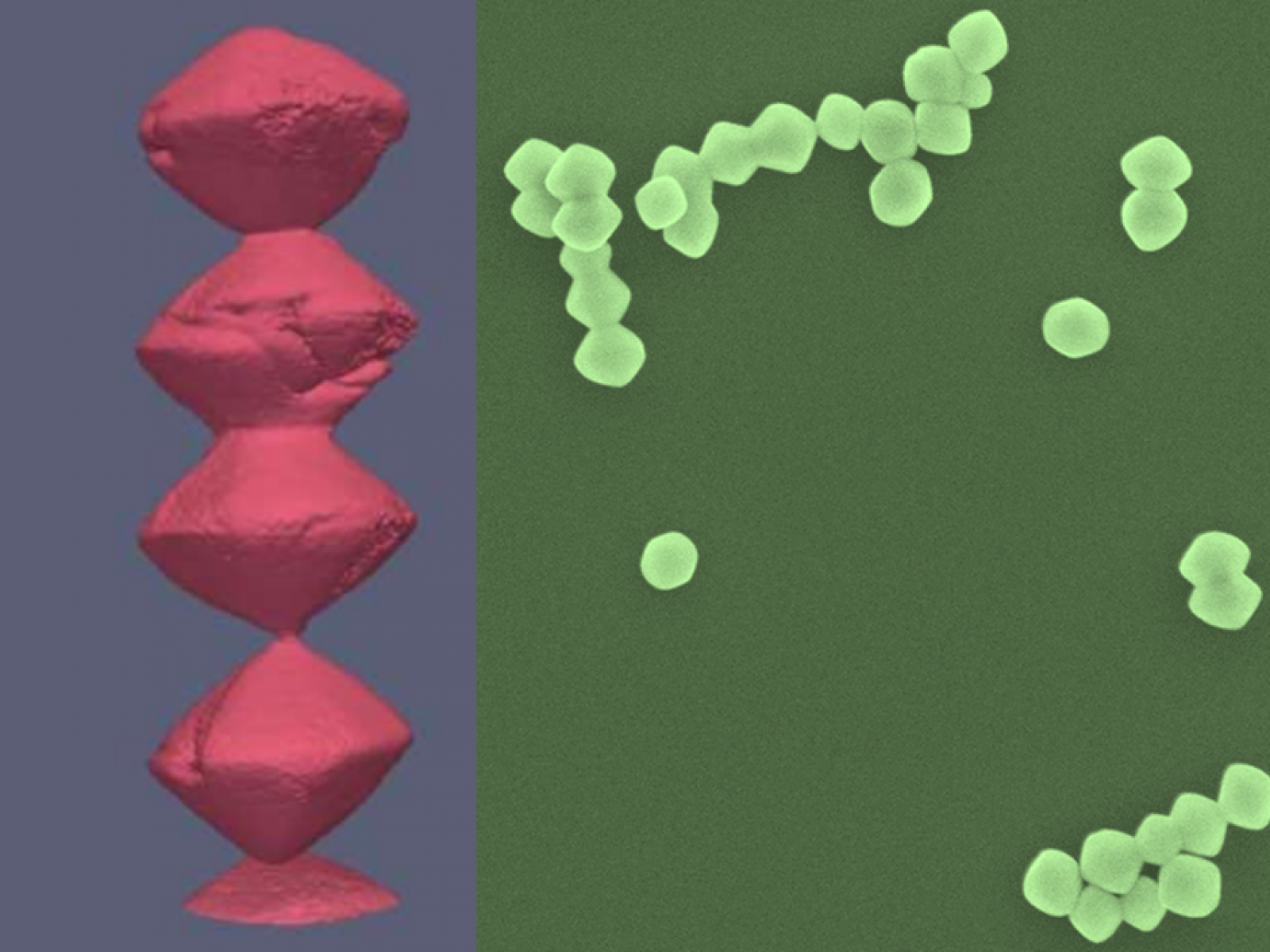Particle-Based Crystallization at Extreme Conditions is Invariant to Initial Nanocrystal Morphology
Under high temperature conditions, hematite nanocrystals change shape to expose the (001) facet and attach to form one-dimensional chains regardless of initial structure

Regardless of their initial morphology, hematite nanocrystals subjected to high temperatures in water will attach along the [001] axis.
(Image by Xin Zhang | Pacific Northwest National Laboratory)
The Science
Crystallization via particle-by-particle attachment is important to the formation of minerals in nature. It has become a popular method to generate advanced materials at laboratory and industrial scales. Understanding the mechanism of particle-based crystallization is critical for designing and developing novel materials as well as predicting and controlling the development of minerals. Researchers discovered a particle-morphology-independent oriented attachment mechanism for hematite, a form of iron oxide, nanocrystals. The particles always align along the [001] direction driven by aligning interactions between (001) faces and repulsive interactions between other pairs of hematite faces. This forms one-dimensional (1D) particle chains.
The Impact
Evidence of particle-based crystallization is routinely observed in natural systems, including at extreme conditions that obscure formation mechanisms. This process is relevant for materials used in fields ranging from energy, catalysis, biomedicine, optics, electrics, to magnetics. The discovery that oriented attachment does not depend on initial particle morphology provides a new conceptual model for interpreting the presence of 1D particle chains. The presence of conditions that enable substantial dissolution/recrystallization is reflected in the equilibrium structures of both the individual particles and final assemblies.
Summary
Understanding the mechanism of particle-based crystallization is a formidable problem due to the complexity of the forces that influence particle dynamics. Oriented attachment (OA) is a particularly challenging phenomenon to study because it occurs only under select conditions and involves precise alignment of particle faces from very small distances. Despite recent progress made in understanding the driving forces for particle face selectivity and alignment, questions about the competition between different formation pathways remain. This study examines high temperature conditions that lead to apparent OA for hematite in water. The researchers used three initial particle morphologies with various exposed faces. All three particle types formed single crystal or twinned 1D chain-like structures along the [001] direction. These were driven by attractive interactions between (001) faces and repulsive interactions between the other hematite faces. Simulations and scanning transmission electron microscopy imaging confirms that the formation of one-dimensional chains is a result of the attachment of independently nucleated particles. These results highlight that strong face specificity along one crystallographic direction can render OA independent of initial particle morphology.
PNNL Contact
Xin Zhang, Pacific Northwest National Laboratory, Xin.Zhang@pnnl.gov
Kevin Rosso, Pacific Northwest National Laboratory, kevin.rosso@pnnl.gov
Maria Sushko, Pacific Northwest National Laboratory, maria.sushko@pnnl.gov
Funding
This work was supported by the Department of Energy, Office of Science, Basic Energy Sciences program, Chemical Sciences, Geosciences, and Biosciences Division through its Geosciences Program at Pacific Northwest National Laboratory (PNNL). A portion of the work was performed at EMSL, the Environmental Molecular Sciences Laboratory, a Department of Energy Office of Science user facility at PNNL.
Published: April 15, 2022
Wang Y., Xue S., Lin Q., Song D., He Y., Liu L., Zhou J., Zong M., De Yoreo J.J., Zhu J., Rosso K.M., Sushko M.L., Zhang X. 2022.“Particle-based hematite crystallization is invariant to initial particle morphology,” Proc. Natl. Acad. Sci. U.S.A., 119 (11) e2112679119. [DOI: 10.1073/pnas.2112679119]